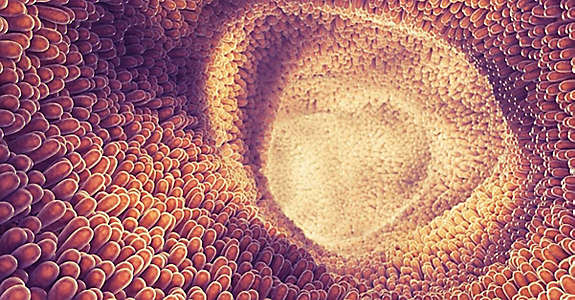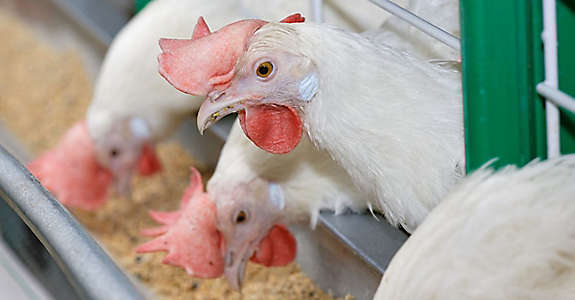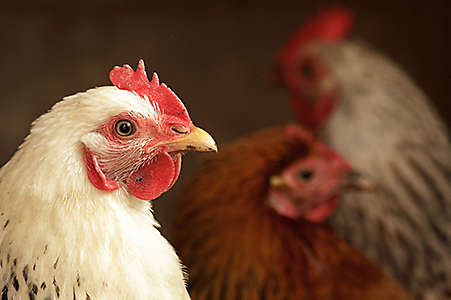Dr. Partha Das, Dr. Venket M Shelke and Dr. Bharat Sadarao
Kemin Industries South Asia Pvt. Ltd.
1. Soybean prices have almost doubled compared to previous years. What are the alternatives to soybean meal you suggest in least-cost feed formulation with their maximum limits both in broilers and layers?
Since Soyabean price has almost doubled compared to last year, feed manufacturers have favorably used different viable alternate sources like Mustard de-oiled cake (DOC), Groundnut DOC, and Cotton DOC among the oilseed cakes (oil extracted variety), Rice distiller's dried grains with solubles (DDGS), Corn DDGS among fermentation Byproducts, Gluten Meals (Maize and Rice), Fish Meal, meat and bone meal (MBM) & Poultry Meal among the alternate animal protein sources. Key factors that governs the best utility of these alternate ingredients in both broilers and layers largely depends on the availability of raw materials with lower variation in nutrient composition, considering the accurate digestibility coefficients and viability of unit cost of protein from these ingredients. But, the most common drawback of these alternate ingredients is their quality, availability, variation in nutrient content, poor digestibility and lack or scarcity of appropriate research or analytical facilities. Another biggest risk factor lies in the greater proportion of Anti Nutritional factors (ANF’s) and adulterants associated with the mentioned alternate raw materials that limits it’s usage in feed. With respect to this, accurate knowledge based on their Digestible amino acid levels (DAA) content by estimating Standard Coefficient of Ileal Digestibility (SIDC), considering ANF’s & adulterants before formulating diets is crucial.
Based on the industry information, most of these ingredients have shown to be beneficial in current market situation for cost optimization, provided, their inclusion levels are considered to a permissible extent and not abnormally high. Please find the chart below (Table-1) that shows correct approach of maximum inclusion levels of the alternative ingredients in broiler and layer diets, based on the Industry practices and critical factors discussed above.
Table-1: Maximum Inclusion levels for Alternative Protein sources (Industry standards).
Alternative Protein Raw Materials (Veg & Animal origin) |
Maximum Usage in diet (%) |
|
Broiler Feed (%) |
Layer Feed (%) |
|
Mustard DOC |
3-4 |
4-5 |
Ground Nut DOC |
4-5 |
4-5 |
Cotton DOC |
3 |
4 |
DDGS |
3-4 |
5-6 |
Maize Gluten |
4-5 |
4-5 |
Fish Meal |
4-5 |
2-3 |
MBM |
4-5 |
3-4 |
Poultry Meal |
4-5 |
3-4 |
Sunflower meal |
2-3 |
5-6 |
DORB |
4-5 |
15-25 |
2. What are the enzymes you recommend minimizing the cost of feed?
Enzymes are very much substrate and site-specific during reaction. Quality of a good enzyme solution depends on the fast and potent reaction with a substrate molecule, broad spectrum activity in different pH, temperature and gut viscosity conditions, synergy of activity with different kinds of enzymes and of course should be thermostable. For least cost feed with better quality consistency, broad spectrum enzyme solution that effectively comprises of Multi non-starch polysaccharides (NSP ases), Slow Release Amylase (sustained amylase activity throughout the gut for better degradation of amylose released from complex carbohydrates in mid gut), Multi Protease (suitable combination of acidic, neutral & alkaline Protease to act in different pH condition of gut) and Phytase (ensure better calcium, phosphorus and other nutrients release) will be highly useful. The key component is considering an ideal matrix from these products to derive a best least cost diet. Considering enzyme matrix will depend on two critical factors, viz. diet density & inclusion level of alternate ingredients. Additionally, since these enzymes work in a synergy, better economic returns can be facilitated with a uniform level of performance that is most desirable in the present context of alternate raw material usage.
3. Do you recommend the use of toxin binders when using different alternative raw materials in least-cost feed formulation?
Yes, definitely it is recommended to use good quality Toxin binder in poultry feed, whether alternative raw materials are used in the diet or not. Toxins, either mycotoxins or chemicals, can be present in both conventionally used and unconventional raw materials, lower levels of which can pose a threat to productivity. Preparing poultry feed without Toxin binder keeps your flocks at high risk and ensuring toxin free raw materials for feed production is not in our grip. While selecting toxin binders, ensure that it has maximum toxin binding (broad spectrum activity) and minimal nutrient binding effect in the gut. In least cost diets, even a slight deviation in terms of nutrient availability of birds may cause serious impact in productivity & this may be augmented if the quality of Toxin binder is compromised in diets. Nowadays, manufacturers are facing crisis for procuring quality raw materials & price is also a big concern. Hence, potent toxin binders with broad spectrum activity with maximum toxin binding & minimal nutrient binding effect should be selected while formulating diets without any compromise.
4. What ratio of digestible lysine to energy level you suggest for broilers, in which case lysine and all the amino acid level will change as the energy level changes
Practically, it is found that there is a wide range of Digestible (Dig) Lysine to Calorie ratios effective for broilers, in terms of its productivity like day gain, feed conversion ratio (FCR), feed intake, breast meat yield, and carcass weight in different phases of life cycle. Industry accepted the facts that suggest Dig. Lysine requirement of 4.15 to 4.5 g/mcal for Pre-starter followed by 3.6 to 3.9 g/mcal for Starter, and 3.1 to 3.5 g/mcal for Finisher diets (values on approximate basis) to be ideally suitable for broilers for uniform productivity and yield. Requirements below these ranges leads to the possibility of deficiency in essential amino acids, which may impact the broiler performance. Values above the cited range may likely lead to energy deprivation and negative energy balance (NEB), since a part of energy is spent for protein synthesis in body. Thus, along with the rise of essential amino acids in diet, a proportionate increase in calorie and vice versa is mandatory.
It is important to keep the Dig Lysine requirement within the mentioned ranges. Maintaining a higher Dig. amino acid values at the expense of calorie within specific Dig. Lysine to Calorie ranges will fetch a better conversion, more effectively in the earlier period of broiler life cycle. All other Dig. amino acids are subjected to change as per ratios to Digestible Lysine.
5. Explain the importance of ideal protein ratios for broiler feeds?
The ideal Protein concept has been an important tool in precisioning the Broiler Nutrition and dietary amino acids requirements. It enables the Nutritionist to adjust the Dig. amino acid needs with the change of production factors, age and breed. In this concept, Dig. Lysine is the reference amino acid and all the remaining essential amino acids are taken as ratios to Dig. Lysine. The basic idea of this concept is that any absorbed amino acid which is relatively excess in body compared to Lysine (the limiting amino acid), will be oxidized and excess Nitrogen will be excreted out. Thereby, adjusting the dietary amino acid supply will help to accelerate Nitrogen utilization. This concept helps to,
- Optimize bird amino acid requirement
- Adjust amino acid supply with change in production conditions, age and breed
- Reduces loss of faecal Nitrogen & ammonia production
- Birds can be optimally reared on low protein diets
- Reduces Cost of Production (COP) of feed and broilers & maximize the Return on Investment (ROI)
6. What are the alternatives to maize with their maximum limits both for broilers and layers?
There are certain energy rich alternate ingredients that can partially replace maize in broiler and layer diets. These mainly includes Bajra, Jowar, Wheat, Wheat Flour, Broken Rice, Maize Gluten, etc. Few factors that limits their usage beyond a certain extent are the anti-nutritional factors (ANF’s), adulterants, variation in raw material quality and digestibility coefficients and Mycotoxins. Inclusion levels higher than the ideal level may lead to risk factors like morbidity, mortality of broilers/ layers, loss of productivity, and profit. In addition to the cereals, their by-products, such as wheat bran, rice bran, rice polish, etc. are used widely in poultry feed. Cereal by-products are typically high in fiber, or non-starch polysaccharide (NSP) content, which are poorly utilized in poultry and are low in Metabolizable Energy (ME).
Before the use of these alternate feedstuffs in the commercial poultry formulations, their limitations of high non-starch polysaccharide, high fiber contents, presence of tannins, phytic acid, toxins, digestibility variation, rancidity, etc. should be identified and managed accordingly. Supplementation of exogenous enzymes on alternative feedstuffs helps to increase the inclusion levels of these ingredients, improves the feeding values, eliminates or reduces the action of anti-nutritive factors, and increases the digestibility and nutritive value. The correct approach for maximum inclusion levels for these ingredients for broilers and layers are given in Table-2.
Table-2: Maximum inclusion levels of Maize Alternatives in Poultry diet.
Alternates to Maize |
Maximum Usage in diet (%) |
|
Broiler Feed (%) |
Layer Feed (%) |
|
Jowar |
20 |
30 |
Rice/ Broken Rice |
10-15 |
15-20 |
Wheat |
5-10 |
10-15 |
Wheat Flour |
5-101 |
10-15 |
Bajra |
20 |
30 |
Rice Polish |
5-8 |
15-20 |
Wheat Bran |
5 |
15 |
7. Which are the feed additives you suggest incorporating when formulating AGP-free diets?
While planning for AGP free diets in poultry, we need to have a holistic approach. Adding feed additives alone will not fulfil the purpose. We need to start it from sourcing quality chicks, maintaining proper cleaning and disinfection of poultry sheds, biosecurity measures, feed raw material quality assessment followed by attention for feed additives that can aid in antibiotics alternative program. Among feed additives, we should give special emphasis on certain products. These are described as follows.
- Second generation probiotics along with phytocompounds for better health of gut microbiome & overall bird health
- Acidifier containing the blend of organic acids and phytochemicals for better intestinal integrity, health & enzyme functions
- Source of energy for enterocytes and maintaining intestinal villi integrity from butyrate products
- Good quality cocktail enzymes fortified with Multi NSPase, Slow release Amylase, Multi Protease and Phytase enzyme for maximum substrate degradation, higher nutrient bioavailability, and minimized undigested feed, Nitrogen & ammonia generation
- Immunomodulators in the form of Algal 1,3 linear beta glucans, which will help to modulate innate immunity
- These mentioned additives will be useful for better health and performances of birds, while formulating AGP free diets by means of the specified suggestions will help to replace AGP in poultry diet
8. Which are the nutrients more critical when formulating the feed for extended laying cycle in layers?
The most critical dietary ingredient in a laying hen diet are amino acids, calcium, and fatty acids, which must be maintained throughout its life, and the same holds true during the extended laying cycle of layers. Amino acids promote protein deposition by converting feed utilization into increased growth during the preparation for the laying period. Calcium and Phosphorus retention during the late laying cycle becomes affected due to the physiological constraints and needs to be replenished properly along with calcium absorption enhancers like Vitamin D3. During the laying season, feed supplemented with polyunsaturated fats is recommended to boost feed intake (FI) and, as a result, egg weight.
Laying hen productivity has increased substantially with a larger number of eggs produced during each laying cycle and a higher efficiency in using feed ingredients. As a result of their increased production, these laying hens become more demanding in terms of nutrients, particularly amino acids. In general, bird growth, growth associated with egg production, and egg production are the three distinct phases with their optimal matching amino acid profiles. Amino acids that are critical in the diet of poultry are arginine, threonine, lysine, methionine, and tryptophan. Although most of the essential amino acids might be a limiting factor, lysine is usually identified as a growth limiting factor, while methionine is frequently identified as a limiting component for egg production. It is reported that methionine and lysine are the first and second limiting amino acids in poultry ration. Threonine and Tryptophan are marginally deficient and careful selection of ingredient can avoid their deficiency. Arginine deficiency is not a problem if groundnut cake is used as ingredients. Maintaining energy intake is more challenging, and this difficulty comes from the fact that feed intake is mainly governed by energy demands. For optimal egg mass generation, a balance of all nutrients is necessary, however, energy intake is frequently a limiting factor among these nutrients. Choline is required as an integral part of the body phospholipid, as a part of acetylcholine and a source of methyl groups during the entire life cycle including late production stages. Feed enzymes are one of the cost-effective and generally acknowledged nutritional strategies for optimizing nutrient retention and laying performance of birds throughout its life cycle including its later stages.



